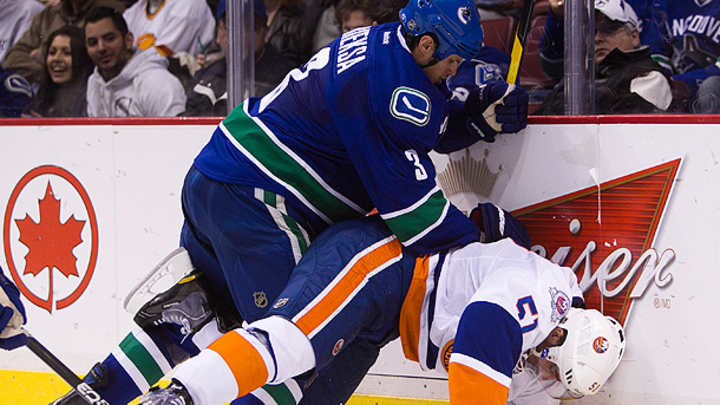Ex-players file class action suit against NHL over concussions

The NHL can say it has worked to reduce dangerous hits like this that result in head injuries. (Bob Frid/Icon SMI)

By Allan Muir
It was never a matter of if the NHL would face a concussion lawsuit similar to the one settled for $765 million by the National Football League earlier this year. It was simply a matter of when.
So league officials could not have been surprised to learn today that a group of 10 former players have banded together to file a class action suit, essentially alleging that the NHL knew about the risks of head trauma and should have taken action long ago to inform and protect players.
GALLERY: NHL careers that were ended by concussions
The suit also argues that the league continues to contribute to injuries today by creating "a culture of violence" through its refusal to ban fighting and body-checking, and by employing “enforcers” whose main job it is to fight.
In response, the NHL issued a statement through deputy commissioner Bill Daly. "We are aware of the class-action lawsuit filed today in the United States District Court for the District of Columbia on behalf of a group of former NHL players," the statement read. "While the subject matter is very serious, we are completely satisfied with the responsible manner in which the league and the players' association have managed player safety over time, including with respect to head injuries and concussions. We intend to defend the case vigorously and have no further comment at this time."
The players involved in the suit spanned three decades of NHL action: Brad Aitken (1990-91), Darren Banks (1992-94), Curt Bennett (1970-80), Richie Dunn (1977-1989), Warren Holmes (1981-84), Gary Leeman (1982-97), Bob Manno (1976-85), Blair Stewart (1973-80), Morris Titanic (1974-76) and Rick Vaive (1979-92).
McCann: Analyzing Leeman v. NHL, the newest sports concussion lawsuit
Although the group doesn't currently include any of the high-profile names who have left the game specifically as a result of head trauma such as Eric Lindros, Pat LaFontaine, Paul Kariya or Keith Primeau, the list is all but certain to grow. The NFL suit started with just 75 players before expanding to represent more than 4,500 athletes.
But no matter how big this group becomes, it's likely to find the NHL is in a much better position to defend itself against this claim than was the NFL.
Hockey's Great Debate: 50 landmark fights and more commentary
It doesn't take an advanced medical degree to understand that a shot to the head is bad for you and repeated blows are probably worse. But the hard science that would support the players' grievance is still emerging, and any conclusions that draw a direct line from an incident of head trauma to long-term, debilitating repercussions are still up for debate. This much, though, is clear: in the years since that science began to build its case, the league has been at the forefront of efforts to understand it and protect its players.
In 1997, the NHL was the first league to create a concussion working group in conjunction with the NHLPA, team trainers and doctors focused on addressing the issue.
It was the first to create baseline testing to quickly diagnose incidents of concussion.
It was the first to create a "quiet room" to properly assess a player's condition with the "Modified SCAT 2" test after an incident of violent head contact.
It was the first to assess suspensions for hits where the primary point of contact is the head.
On top of these efforts, the league has an even more intriguing card to play. It has established itself, time and again, as the entity most interested in safety, often battling the objections of the very players it's trying to protect from harm.
The players routinely stand for comfort and tradition over safety. They fought the league on the introduction of mandatory helmet usage back in 1979. They obstructed efforts to make the use of visors mandatory before finally agreeing to grandfather them in earlier this year.
And it is the players who have repeatedly stated their support of fighting as an integral element of the game. Not that the NHL has moved directly to address it, but if there is a "culture of violence" in hockey, the players have been, and continue to be, complicit in its maintenance.
